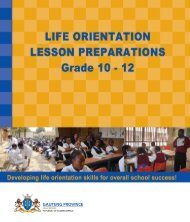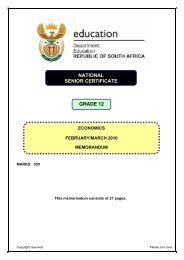Life Science Grade 11
Life Science Grade 11
Life Science Grade 11
You also want an ePaper? Increase the reach of your titles
YUMPU automatically turns print PDFs into web optimized ePapers that Google loves.
<strong>Grade</strong> <strong>11</strong> <strong>Life</strong> <strong>Science</strong>s Lesson PlansGRADE <strong>11</strong> SUBJECT <strong>Life</strong> <strong>Science</strong>s WEEKWeek 2TOPICGrowth of mould on differentsubstrates (Practical)LESSON 4LESSON SUMMARY FOR: DATE STARTED:DATE COMPLETED:Content:• Growth of different types of mould on different substrates such as fruit, vegetables, bread• Different structures of different moulds growing on different substratesLESSON OBJECTIVESThe learners must be able to:• Work together in a group• Follow instructions• Record observation as drawings• Successfully use a microscope to observe the different samples of mould• Identify the different structures of the moulds observedTEACHER ACTIVITIES LEARNER ACTIVITIES TIMING RESOURCES NEEDED1. Practical work: Growth of mould on different substrates1.1 Introduction• Pre-knowledge: Use of a microscope• Briefly go through safety rules in laboratory when handling apparatus such as a microscopeand precautions necessary to take when handling moulds2.2 Main Body (Lesson presentation)• Divide the learners into groups (not more than 6 per group)• Give learners the following instructions for preparing slides of various samples of moulds:• Make slides of the various moulds by taking a small scraping from the substrate and placinga small amount on the slide• Place a drop of water on the sample and cover with a cover slip• Observe slide under the microscope (Learners should note that different moulds will havedifferent structures depending upon the substrate it grows on)• Carefully examine the slides for the hyphae of the fungi and moulds, the spores containedin sporangia and cell walls of individual cells• Draw and label those parts of each organism you have observed.• Learners must clean work stations1.2 Conclusion• Remind learners of the major structures found in mould and fungi• Confirm that the three structures (hyphae, sporangia and cell walls) were observed• Questions at end of activity in Solutions for all text book may be assigned for homework1. Group work:Following instructions, preparingslides of different moulds, makingobservations in the form ofdiagrams2. Learners must draw and labeldiagrams to show the variousstructures observed in theirWorkbooksHomework (if assigned)10 min25 min10 min20 min• Samples of old bread,cheese, fruit andvegetables with mouldgrowing on it• Sharp blade, scalpel orknife• Slides and cover slips• Microscopes• Practical Ref:• Solutions for all <strong>Life</strong><strong>Science</strong>s <strong>Grade</strong> <strong>11</strong>pp.12 - 13• Internet reference forpractical work:http://www.experiment-resources.com/moldbreadexperiment.htmlTerm 1 Page 17© Gauteng Department of Education (CAPS version)







